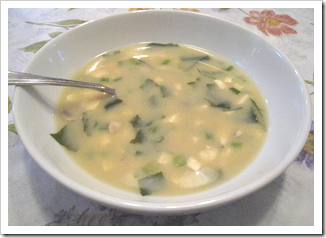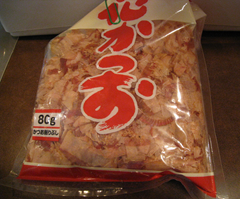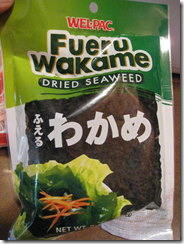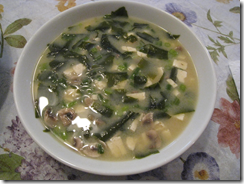Miso Soup is pretty quick and easy to make! I made it for the first time this past weekend. My whole family liked it, though my 7 year old daughter only ate the broth with rice (no seaweed!).
The one possibly tough part of making miso soup is finding the ingredients. I got mine at a Japanese specialty food store in a nearby town. The owner also gave me tips about making the soup! So it was an interesting trip. If you don’t have a store like this nearby, you can get the ingredients on the internet.
I made a large pot. So I’ll give you the quantities I used for the recipe. Then I’ll tell you how much you need to make a small quantity and you can double it or triple it or whatever you want. It’s good to learn how to adapt recipes to your own needs.
Here are the quantities I used to make a large pot of soup:
20 cups of water
5 cups of Dried Bonito Flakes (mackerel)
1 1/2 cups White Miso Paste
1/4 to 1/3 cup Dried Chopped Seaweed
1 to 3 bunches Thinly Sliced Scallions
1 (4 to 8 oz) package Cleaned White Mushrooms, Thinly Sliced (If desired)
1 to 2 (14 ounce) Packages Firm Tofu, Cubed
Salt to taste (you can also use a little sea salt if desired)
First you make the Dashi which is the the broth for the soup. Ayako Egawa from Japan gave me instructions for making this. The rule of thumb is to use 2 cups of water to 1/2 cup dried bonito flakes (pictured below).
1. Here’s how you make the Dashi Broth:
Boil the water. Turn off the flame. Put dried bonito into the water and stir. Let sit for 10 minutes. Then you want to take out the bonito. You can do this by straining the broth through a colander and into another pot. I did the straining twice to get rid of all the bonito. Then you discard the bonito. The broth that’s left is the Dashi.*
2. Put the broth in the pot back on the stovetop and warm it up on a medium to medium-high flame. But do not boil it – especially after the miso has been added. Many people believe boiling miso ruins its beneficial health effects.
3. Add the miso paste (the rule of thumb is 1 Tablespoon of miso paste per 1 cup of water.) Stir in the miso paste to dissolve. Add the other ingredients (feel free to leave out any if you don’t like them). Note: I used the seaweed in the photo below – a little goes a long way! I originally put in 1/2 cup and you can see how much is in the bowl at the bottom. That’s why I changed the amount in the recipe to 1/4 to 1/3 cup. (I think a rule of thumb would be about 1 teaspoon dried seaweed per 1 – 2 cups of water. I would start with less, you can always add more!)
You can adjust the amounts of the mushrooms, tofu, scallions and seaweed used to suit your family’s taste. (Some people even put in carrots, buckwheat noodles and even a little sesame oil and soy sauce.) We wanted a lot of scallions – and I think it added flavor to the broth. Whatever you choose, simply warm up the final ingredients, add salt to taste, and voila, it’s ready to eat!
*FYI Ayako and the man in the Japanese food store both pointed out that you can alternatively make the Dashi (broth) by using Dashi powder – but the versions of Dashi powder that I found had MSG in it. That’s why I made it with the Dried Bonito Flakes instead. The man in the store insisted that restaurants use the powder, making me wonder if we’re eating MSG when we have miso soup in some restaurants. I guess that’s all the more reason to learn to make it yourself! This way you know exactly what’s in it!
Many thanks to Ayako Egawa for teaching me how to make dashi!
Enjoy!
Mama Lisa
PS Here’s "The Miso Soup Song" – a Korean Folk Song
UPDATE: Check out this later post to learn about some Miso Soup Traditions!
This article was posted on Tuesday, May 19th, 2009 at 6:41 pm and is filed under Countries & Cultures, Cuisine, Dashi, Japan, Japanese Cuisine, Miso Soup, Recipes of the World, Soup. You can follow any responses to this entry through the RSS 2.0 feed. You can skip to the end and leave a response. Pinging is currently not allowed.





























May 20th, 2009 at 12:42 am
Yum! Looks delicious. I love wakame but never think to add it to miso.
May 24th, 2009 at 3:22 pm
[…] recently posted a recipe for miso soup that Ayako Egawa from Japan helped me with. When she saw the photo of the bowls and spoons I […]
May 24th, 2009 at 3:25 pm
Ayako Egawa (who helped me with the recipe above) wrote to me later: “Hi Lisa, Your Miso soup is nicely done! It looks yummy! Your recipe is very good for beginners, too!
Actually I’ve never made Dashi from dried bonito. I usually use Dashi powder. So your Dashi is real!
I add vegetables such as Japanese radish, onions, potatoes to it, any vegetables are O.K.. It is true some vegetables add flavor to it. And I know how bigger dried seaweeds become!
It is nice your family liked Miso soup. Nicely done, Lisa!
Ayako”
Thanks Ayako and I appreciate your help! -Mama Lisa
July 17th, 2009 at 9:39 am
Miso Paste Marinade…
Prefect Miso – Miso Paste Marinade.
Most of Japanese recipes is using ingredients such as mirin, soy sauce, dashi stock, miso, sake etc to create traditional Japanese taste. By combining these ingredients, you can create you own favorite taste.
Most o…
July 20th, 2009 at 9:39 am
Miso Radish…
This is continue of the previous post. The most famous and suitable vegatable to marinade in miso paste is Japanese radish or “Daikon” (大根) in Japanese.
Ingredients:
1 radish (daikon)
Miso paste seasoning:
300g miso paste
135g fine sug…
August 1st, 2009 at 8:57 pm
Thank you SOOO much!
September 19th, 2010 at 3:48 pm
[…] The carrot cake was divine (recipe from a later edition of Joy of Cooking). I got the recipe for the miso soup from my friend Ayako in Japan. And I still haven’t tried […]